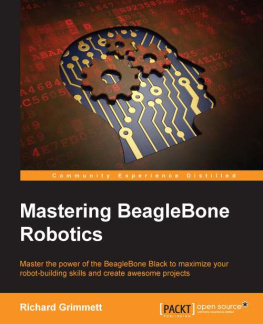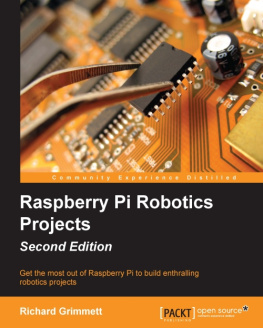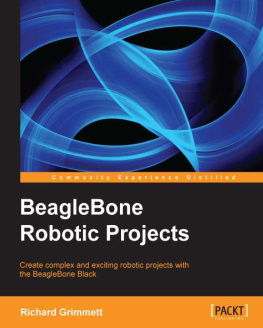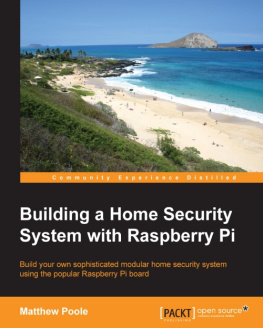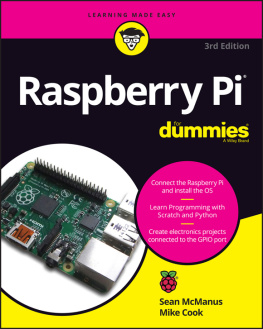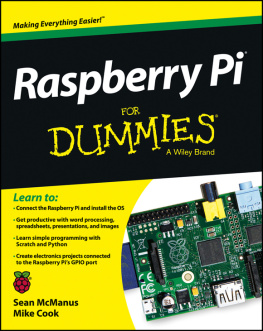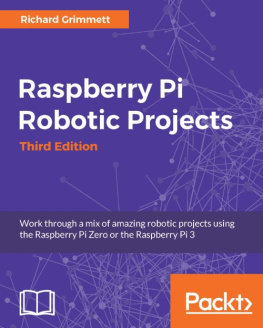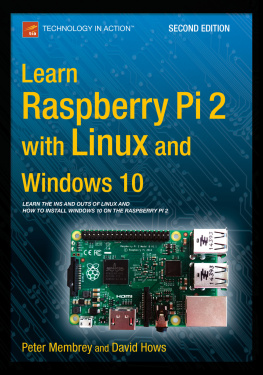Raspberry Pi Robotic Projects - Third Edition
Copyright 2016 Packt Publishing
All rights reserved. No part of this book may be reproduced, stored in a retrieval system, or transmitted in any form or by any means, without the prior written permission of the publisher, except in the case of brief quotations embedded in critical articles or reviews.
Every effort has been made in the preparation of this book to ensure the accuracy of the information presented. However, the information contained in this book is sold without warranty, either express or implied. Neither the author, nor Packt Publishing, and its dealers and distributors will be held liable for any damages caused or alleged to be caused directly or indirectly by this book.
Packt Publishing has endeavored to provide trademark information about all of the companies and products mentioned in this book by the appropriate use of capitals. However, Packt Publishing cannot guarantee the accuracy of this information.
First published: February 2014
Second edition: April 2015
Third edition: October 2016
Production reference: 1041016
Published by Packt Publishing Ltd.
Livery Place
35 Livery Street
Birmingham
B3 2PB, UK.
ISBN 978-1-78646-796-6
www.packtpub.com
Credits
Author Richard Grimmett | Copy Editor Safis Editing |
Reviewer Jon Witts | Project Coordinator Suzanne Coutinho |
Commissioning Editor Kartikey Pandey | Proofreader Safis Editing |
Acquisition Editor Tushar Gupta | Indexer Rekha Nair |
Content Development Editor Merint Mathew | Graphics Abhinash Sahu |
Technical Editor Hussain Kanchwala | Production Coordinator Shraddha Falebhai |
About the Author
Richard Grimmett has always been fascinated by computers and electronics from his very first programming project that used Fortran on punch cards. He has a bachelor's and master's degree in electrical engineering and a PhD in leadership studies. He also has 26 years of experience in the Radar and Telecommunications industries and even has one of the original brick phones. Currently, he teaches computer science and electrical engineering at Brigham Young University, Idaho, where his office is filled with many of his robotics projects.
This book is the result of working with many of the wonderful students at BYU-Idaho. It also wouldnt be possible without the help of my wonderful wife, Jeanne.
About the Reviewer
Jon Witts has been working in the IT industry since 2002, specifically in educational IT since 2004. He was introduced to Linux back in 2001 through his collaboration with two German artists who were visiting the arts organisation he was then working with. Having studied fine arts and educational technology, he sought to innovate with open and accessible digital technologies within his creative practice and is happiest when deconstructing technology and finding its limits.
Jon has embedded the use of Raspberry Pi computers in his school as an integral part of the delivery of the computer science curriculum, as well as to run various school clubs and projects. Jon is a Raspberry Pi Certified Educator and also helps to organize and run the Hull Raspberry Jam events.
I would like to thank my wife, Sally, and our three daughters for putting up with all the cables and components around the house, and not least for being so tolerant of the need to dodge the robots racing around the kitchen floor!
www.PacktPub.com
For support files and downloads related to your book, please visit www.PacktPub.com.
Did you know that Packt offers eBook versions of every book published, with PDF and ePub files available? You can upgrade to the eBook version at www.PacktPub.com and as a print book customer, you are entitled to a discount on the eBook copy. Get in touch with us at service@packtpub.com for more details.
At www.PacktPub.com, you can also read a collection of free technical articles, sign up for a range of free newsletters and receive exclusive discounts and offers on Packt books and eBooks.
https://www.packtpub.com/mapt
Get the most in-demand software skills with Mapt. Mapt gives you full access to all Packt books and video courses, as well as industry-leading tools to help you plan your personal development and advance your career.
Why subscribe?
- Fully searchable across every book published by Packt
- Copy and paste, print, and bookmark content
- On demand and accessible via a web browser
Preface
With the introduction of the Raspberry Pi just a few short years ago, a whole new world of do-it-yourself projects have come to life. This inexpensive but powerful processor provides a wide range of possibilities. When married with third-party hardware and free open source software, the opportunities are endless.
This book provides a step-by-step guide to at least some of these projects. Each chapter will introduce you to a new and different type of project. Each project will have very specific challenges and opportunities to learn new and cool ways to use the Raspberry Pi. Now, these chapters are really just an introduction to the topic; each of these projects would take an entire book to cover all the different aspects.
The book will hopefully inspire you to take the many different skills you have learned and mix and match them into entirely different projects with new and creative capabilities. Explore, for that is the overall theme of this book and of the Raspberry Pi.
What this book covers
, Getting Started with the Raspberry Pi , covers the details of setting up a useful development environment on the Raspberry Pi. The chapter begins with a discussion on how to connect power and continues through setting up a full system that is configured and ready to begin connecting any of the amazing devices and software capabilities to develop advanced robotics applications.
, Building Your Own Futuristic Robot , talks about the amazing things you can do with the Raspberry Pi, such as control a wheeled robot. This chapter will show you how to add a motor control so you can build your very own autonomous mobile robot. Additionally, one of the amazing features of todays computer system is the ability to input commands and provide output without a screen or keyboard. A few years ago, the concept of a computer that can talk and listen was science fiction, but today it is becoming a standard part of new cell phones. Youll take a standard toy R2D2 and turn it into a responsive robot.
, Building a Wall-E Robot , talks about another impressive robotic project, which is a robot modeled after Wall-Ea robot with a tracked base and articulating arms. Servos can be controlled using the Raspberry Pi and some additional USB-controlled hardware. Our robot will also use a Microsoft Kinect to not only have vision but depth perception as well.



